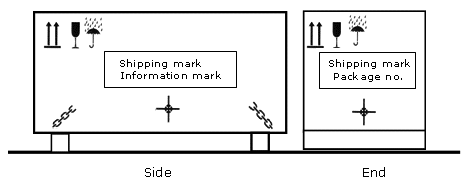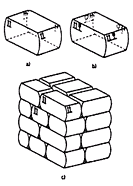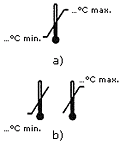Correct and complete marking of packages helps to prevent incorrect handling, accidents, incorrect delivery, losses of weight and volume and Customs fines.
Marking must be clear and precise. Its color should stand out clearly from that of the package; black RAL 9005 paint is used. Alternatively, it may also be applied on adhesive labels. Black symbols on a white background should be used. Both when the marking is applied directly onto the package and when adhesive labels are used, care must be taken to ensure that marking is applied in a legible and durable manner.
Adequate marking is an indispensable component of the package. If the marking is at variance with the details on the shipping documents, objections may be raised by the Customs authorities. Damage can result from inadequate handling marking.
Complete marking must comprise the following three parts as laid down in DIN 55 402
Part 2:
- Shipping mark
- Information mark
- Handling instructions
The shipping mark:
- Identification mark: e.g. initial letters of receiver or shipper or of receiver’s company name
- Identification number: e.g. receiver’s order number
- Total number of items in the complete consignment
- Number of the package in the consignment, e.g. 6/12 or 6 – 12
- Place and port of destination
The information mark:
- Country of origin: The country of origin must be stated in accordance with the provisions of the particular countries. The statement of the country of origin is often mandatory. In some cases it is not desired and, if contractually agreed, may have to be omitted.
- Indication of weight of package: from a gross weight of 1,000 kg, packages must be marked with details of weight. To facilitate transport, handling and storage, the relevant standards also recommend indicating weight from a lower threshold.
- Dimensions of packages: Dimensions must be stated in centimeters.
The handling instructions:
"Handling marks" help to ensure that greater care is taken with cargo handling and storage. It must be possible to tell,
- whether the package is sensitive to heat or moisture
- whether it is at risk of breakage
- where the top and bottom are and where the center of gravity is located
- where loading tackle may be slung
Special markings:
The symbols for package handling instructions are internationally standardized in ISO 780 and in DIN 55 402. These symbols must never be omitted as they are self-explanatory and so overcome language problems in international transport operations. Handling symbols can be applied using templates, stamps, embossing or branding (with the exception of slinging marks).
Written text must run parallel to the bottom edge of the package. It must be readable when the package is in its normal transport position. All labeling should use Arabic numerals and uppercase alphabetic letters. The size of the letters will depend on the amount of space available. Letter sizes of 12.5 mm, 25 mm, 45 mm, 70 mm or 100 mm are used by choice. The letters and numerals of the shipping mark must be larger than any other text markings. All letters and numerals must be smaller than the pictorial symbols applied to the package. Text characters should be applied with templates wherever possible.
In the case of goods which are shipped partially packaged, the markings must be applied directly to the packaged goods. The marking and the packaged goods must have different color tones. It is also possible to attach plywood, plastic or metal plates to the packaged goods in such a way that they do not become detached.
Plywood plates must always use weatherproof glue. Marking using templates is to be preferred.
Markings must be applied to at least two sides of a package and on rough-sawn lumber, the letter size must be at least 20 mm. Markings on all four sides considerably facilitate transport and handling.
The surfaces on which the markings are applied must be such that the resulting text is unbroken and easily read. The markings must correspond to the shipping documents.
Only those handling instructions are permitted that are required by the packaged goods.
Old markings must be completely erased.

Figure 111: Example of markings on a box
| Shipping mark |
| |
Example of markings |
| 1. Identification mark: |
GDV |
| 2. Identification number |
ABC 123 |
3. Package no. If necessary, also
total number of packages |
5 / 25 |
| 4. Destination |
PITTSBURGH |
| 5. Port of destination |
VIA NEW-YORK |
| Information mark |
| 6. Country of origin |
MADE IN GERMANY |
| 7. Net weight |
[kg] |
| 8. Gross weight |
[kg] |
| 9. Dimensions |
[cm] |
Table 15: Shipping mark and information mark
| No. |
Meaning of the symbol |
Symbol |
Function |
Comments |
1. |
Fragile |
 |
The contents of the package are fragile and must therefore be handled with care. |
ISO 7000, No. 0621. Example of use:
 |
2. |
Use no hooks |
 |
No hooks may be used when handling this package. |
ISO 7000, No. 0622 |
3. |
Top |
 |
Indicates the correct, upright position of the package. |
ISO 7000, No. 0623. Example of use:
 |
4. |
Keep away from heat |
 |
The package must be protected from heat. |
ISO 7000, No. 0624 |
5. |
Protect from radioactive sources |
 |
The contents of the package can be degraded or rendered useless as a result of radioactivity. |
ISO 7000, No. 2401 |
6. |
Keep dry |
 |
The package must be kept in a dry environment. |
ISO 7000, No. 0626 |
7. |
Center of gravity |
 |
Indicates the center of gravity of a package that is to be handled as a single unit. |
ISO 7000, No. 0627. Example of use:
 |
8. |
Do not roll |
 |
The package must not be rolled. |
ISO 7000, No. 2405 |
9. |
No hand truck here |
 |
Hand trucks must not be used on this side to handle the package. |
ISO 7000, No. 0629 |
10. |
Do not use forklift truck here |
 |
The package must not be handled using forklift trucks. |
ISO 7000, No. 2406 |
11. |
Clamp here |
 |
Clamps must be applied to the sides indicated to handle the package.
|
ISO 7000, No. 0631 |
12. |
Do not clamp here |
 |
No clamps may be applied to the sides indicated to handle the package.
|
ISO 7000, No. 2404 |
13. |
Stacking weight limitation |
 |
Indicates the maximum stacking load for packages. |
ISO 7000, No. 0630 |
14. |
Stacking limitation |
 |
Maximum number of identical packages that may be stacked, where n stands for the number of permitted packages.
|
ISO 7000, No. 2403 |
15. |
Do not stack |
 |
Stacking of the packages is not permitted and no loads should be placed on the package.
|
ISO 7000, No. 2402 |
16. |
Sling here |
 |
Slinging equipment must be applied as shown in order to lift the package. |
ISO 7000, No. 0625. Example of use:
 |
17. |
Permitted temperature range |
 |
Indicates the temperature range within which the package must be stored and handled. |
ISO 7000, No. 0632. Example of use:
 |
18. |
Electrostatic sensitive device |
 |
Contact with packages bearing this symbol should be avoided at low levels of relative humidity, especially if insulating footwear is being worn or the ground/floor is nonconductive. Low levels of relative humidity must in particular be expected on hot, dry summer days and very cold winter days.
|
|
19. |
Do not destroy barrier |
 |
A barrier layer which is (virtually) impermeable to water vapor and contains desiccants for corrosion protection is located beneath the outer packaging. This protection will be ineffective if the barrier layer is damaged.
Since the symbol has not yet been approved by the ISO, puncturing of the outer shell must in particular be avoided for any packages bearing the words "Packed with desiccants".
|
|
20. |
Tear open here |
 |
This symbol is intended only for the recipient. |
|
21. |
Do not expose to magnetic fields |
 |
|
|
22. |
Only transport on upper layer
or:
Top layer
or:
Do not stack |
 |
|
|
Table 16: Standardized handling instructions
|


























